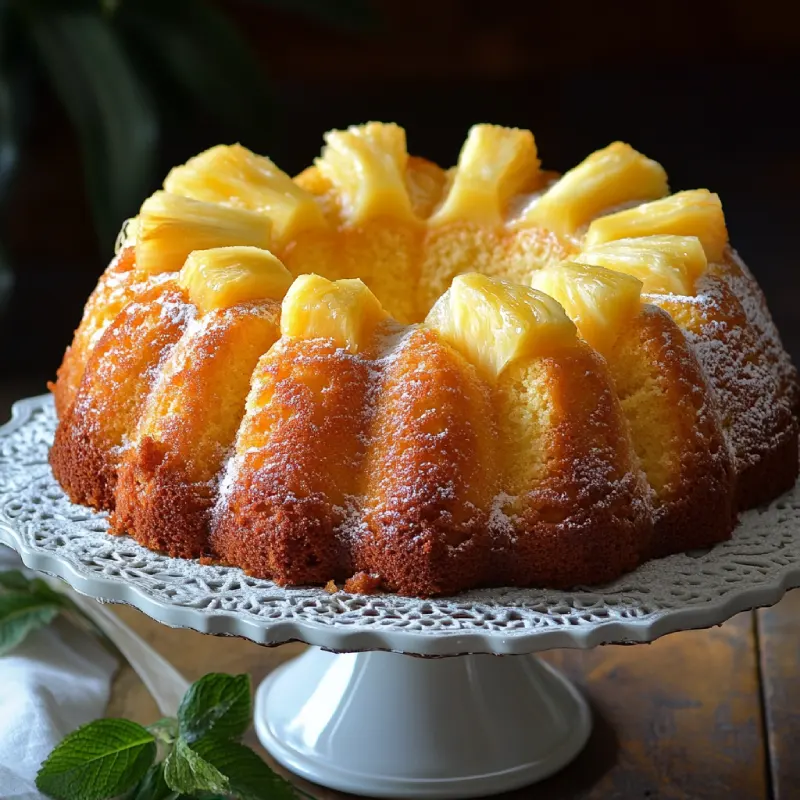Introduction to Pineapple Pound Cake
Pineapple pound cake, a beloved dessert, skillfully combines the rich, buttery texture of traditional pound cake with the sweet, tropical flair of pineapples. This cake has garnered a special place in both home kitchens and professional bakeries due to its delightful flavor and moist texture, making it a favorite for many.
The origin of pineapple pound cake can be traced back to the adaptation of classic pound cake recipes, which traditionally included a pound each of flour, butter, eggs, and sugar. The introduction of pineapple—whether fresh, canned, or in juice form—into these recipes added a new dimension of flavor and moistness that enhanced the overall appeal of the cake. This adaptation showcases the versatility of pound cake recipes, which have been embraced and modified with various fruits and flavors over the centuries.
Pineapple pound cake not only serves as a delicious dessert but also holds a place in culinary history as an example of how traditional recipes evolve and adapt to incorporate local or trending ingredients, reflecting cultural tastes and preferences.
Classic Pineapple Pound Cake Recipe
Enjoy the sweet and tangy flavors of a classic pineapple pound cake with this detailed recipe. Here’s a step-by-step guide to creating this delicious dessert that is perfect for any occasion.
Ingredient List
- All-purpose Flour: 2 cups, sifted
- Butter: 1 cup, unsalted and softened
- Sugar: 1 cup, granulated
- Eggs: 4 large, at room temperature
- Crushed Pineapple: 1 cup, well-drained
- Vanilla Extract: 1 teaspoon
- Baking Powder: 1 teaspoon
- Salt: 1/2 teaspoon
- Optional Glazes or Toppings: Powdered sugar, pineapple glaze, or cream cheese frosting
Preparation Steps
- Prep Work:
- Preheat your oven to 325°F (165°C).
- Grease and flour a 10-inch bundt pan or loaf pan.
- Mix Dry Ingredients:
- In a medium bowl, whisk together the sifted flour, baking powder, and salt.
- Cream Butter and Sugar:
- In a large mixing bowl, cream the softened butter and sugar until light and fluffy, about 3-4 minutes with an electric mixer.
- Add Eggs and Vanilla:
- Add eggs one at a time, beating well after each addition. Stir in vanilla extract.
- Incorporate Pineapple:
- Fold in the drained crushed pineapple into the mixture, ensuring it’s evenly distributed.
- Combine with Dry Ingredients:
- Gradually add the dry ingredients to the wet mixture, mixing on low speed just until the flour is incorporated.
- Bake:
- Pour the batter into the prepared pan and smooth the top with a spatula.
- Bake in the preheated oven for 60 to 70 minutes, or until a toothpick inserted into the center of the cake comes out clean.
- Cool and Serve:
- Allow the cake to cool in the pan for 10 minutes, then turn out onto a wire rack to cool completely.
- If using, apply your choice of glaze or sprinkle with powdered sugar before serving.
Baking Tips
- Ingredient Temperature: Ensure all ingredients, especially butter and eggs, are at room temperature to achieve a smooth, even batter.
- Mixing: Avoid over-mixing the batter once the flour is added, as this can lead to a denser texture.
- Checking Doneness: Use a toothpick or a cake tester to check the cake. It should come out clean or with just a few moist crumbs attached.
This pineapple pound cake is not only delightful in taste but also brings a moist and dense texture that’s typical of pound cakes, with the added tropical twist of pineapple.
Recipe Variations for Pineapple Pound Cake
Adapting the classic pineapple pound cake to suit various dietary preferences or flavor profiles can refresh this beloved recipe. Below are variations to make it gluten-free, vegan, or simply add a twist with different flavors.
Gluten-Free Version
- Substituting Flour: Replace all-purpose flour with a gluten-free flour blend designed for baking. Look for blends that include xanthan gum, which helps mimic the texture and elasticity of gluten.
- Additional Adjustments: Gluten-free flours can sometimes create a drier texture, so consider adding a small amount of extra liquid (like pineapple juice) to maintain moisture.
Vegan Adaptation
- Dairy and Eggs Replacement:
- Use plant-based butter and a non-dairy milk alternative in place of regular butter and milk.
- Substitute eggs with flax eggs (1 tablespoon ground flaxseed mixed with 3 tablespoons water per egg, set to thicken for 5 minutes) or commercial egg replacers.
- Check Ingredients: Ensure that the pineapple and any added flavorings or toppings are also vegan.
Flavor Variations
- Fruits and Nuts:
- Mix in different fruits such as mango or banana for a tropical twist.
- Add chopped nuts like pecans or almonds for added texture and richness.
- Spices:
- Incorporate spices such as cinnamon, nutmeg, or cardamom to complement the pineapple flavor and add warmth.
These variations encourage experimentation while maintaining the integrity of the traditional pineapple pound cake.
Nutritional Insights for Pineapple Pound Cake Ingredients
The key ingredients in pineapple pound cake not only contribute to its delicious taste but also offer various health benefits. Here, we’ll explore the nutritional aspects of these ingredients and provide considerations for those monitoring their sugar or fat intake.
Health Benefits of Key Ingredients
- Pineapple: This tropical fruit is not just flavorful; it’s also packed with vitamins, enzymes, and antioxidants. Pineapples are rich in vitamin C, which supports the immune system, and manganese, essential for metabolism and antioxidant defenses. They also contain bromelain, an enzyme that may help with inflammation and digestion.
- Butter: Provides vitamin A and fatty acids that are essential for skin health and cellular functions. However, it’s also high in saturated fats, which should be consumed in moderation.
Considerations for Dietary Restrictions
- Sugar Intake: Traditional pineapple pound cake recipes can be high in sugar. For those looking to reduce sugar intake, substituting granulated sugar with alternatives like coconut sugar, which has a lower glycemic index, or using natural sweeteners like honey, can be beneficial. These substitutions not only decrease the amount of refined sugar but also can add interesting flavors to the cake.
- Fat Intake: For those monitoring fat intake, reducing the amount of butter or substituting part of it with unsweetened applesauce or Greek yogurt can help lower the overall fat content. This substitution still maintains moisture but with fewer calories and less saturated fat.
By making informed choices about the ingredients in pineapple pound cake, individuals can enjoy this delicious dessert while aligning it with their health and dietary goals.
FAQs: Storing, Serving, and Troubleshooting Pineapple Pound Cake
Proper storage, presentation, and solving common baking problems are essential for perfecting and enjoying your pineapple pound cake. Here are some frequently asked questions with expert advice to help you make the most of this delicious dessert.
Best Practices for Storing and Preserving Freshness
- Short-Term Storage: Wrap the cake tightly in plastic wrap or aluminum foil, or place it in an airtight container. It can be stored at room temperature for up to three days.
- Long-Term Storage: For longer preservation, wrap the cake well and store it in the refrigerator for up to seven days, or freeze it for up to three months. Always thaw frozen cake in the refrigerator overnight before serving.
Tips on Serving Pineapple Pound Cake
- Serving Temperature: Serve the cake at room temperature to best enjoy its flavors and texture.
- Pairing Suggestions:
- With Beverages: Complement the tropical notes of the pineapple with a cup of coffee or tea, or a glass of sparkling wine for a festive touch.
- With Other Desserts: Serve alongside coconut ice cream or mango sorbet to enhance the tropical theme, or with a berry compote for a sweet and tart contrast.
Advice on Troubleshooting Common Baking Issues
- Underbaking: If the cake is dense or wet in the middle, extend the baking time and check with a toothpick or cake tester until it comes out clean. Ensure your oven is properly calibrated for accurate temperature settings.
- Stickiness: A sticky top can be charming, but if it’s excessive, it might be due to high moisture content in the pineapple. Make sure to drain the pineapple well if using canned, or adjust the sugar amount slightly as it can draw moisture to the surface as the cake cools.
Conclusion: Celebrating Pineapple Pound Cake
The journey through crafting the perfect Pineapple Pound Cake highlights not only the versatility of this delightful dessert but also its ability to bring a touch of tropical flavor to any dining table. Whether enjoyed as a summery treat or a festive holiday dessert, this cake’s rich texture and vibrant pineapple flavor make it a standout favorite.
- Versatility and Appeal: Pineapple pound cake adapts beautifully to various occasions and dietary preferences, proving itself as a versatile choice for bakers and dessert lovers alike.
- Culinary Creativity: This exploration encourages culinary enthusiasts to experiment with modifications and variations—whether making it gluten-free, vegan, or adding unique twists with different fruits or toppings.
As you continue your baking adventures, remember that pineapple pound cake offers a wonderful canvas for experimentation. Each variation not only adds a new layer of flavor but also personalizes the cake to suit different tastes and occasions.

